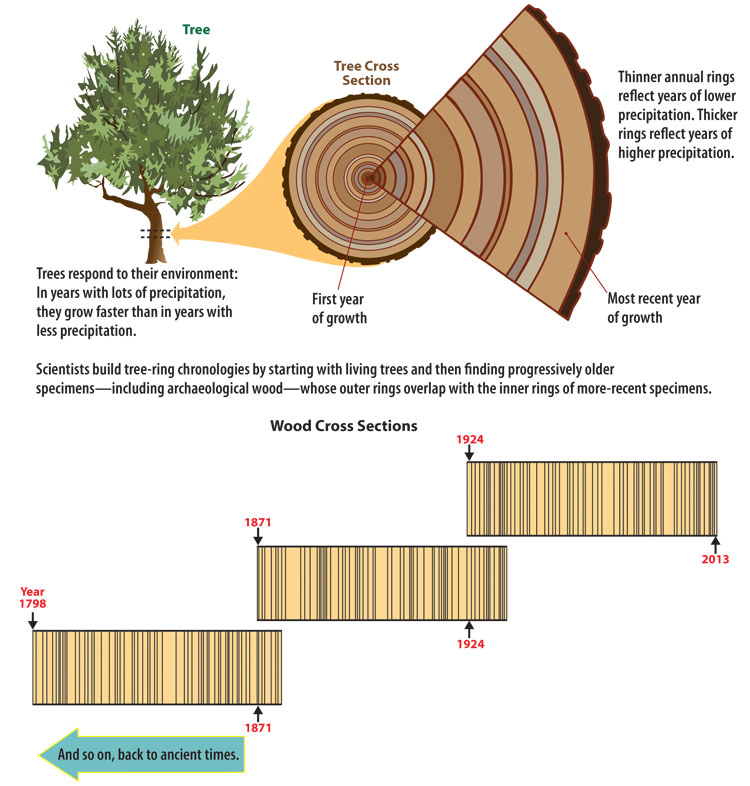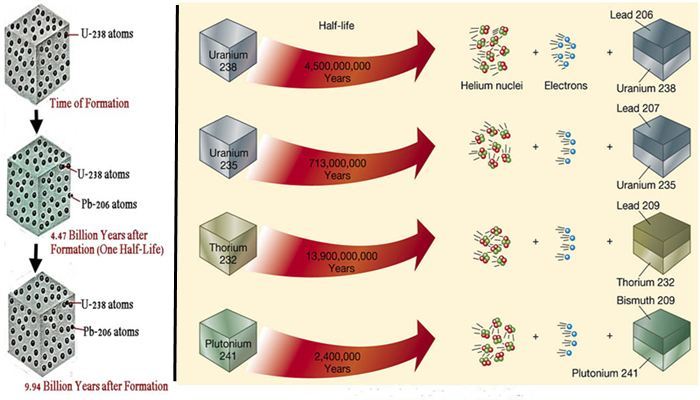Dating Technology
Dating technology describes several techniques for establishing the ages of
various ancient natural objects and artefacts. Different methods are used,
depending on the nature of the objects, which range from 4 billion-year-old rocks
at one end of the spectrum to 19th-century wooden timbers at the other.
These methods are indispensable research tools for geologists, anthropologists,
and archaeologists.

Many dating methods are based on the phenomenon of radioactivity.
Some chemical elements have unstable forms, called radioactive isotopes,
whose atoms spontaneously "decay" over time. Decay usually involves an
atom of the isotope changing into an atom of a different element and
simultaneously releasing an alpha or beta particle (radiation). The rate at
which a given isotope decays is constant and is expressed as its half-life,
which provides an in-built clock within any object that was formed with a
radioactive isotope incorporated into its structure.. Some such objects are
dated by measuring the ratio of the isotope to its decay products (the method
used in radiometric rock dating), others by establishing how much of the isotope
remains in relation to the stable form of the same element (the method used in
radiocarbon dating). A further method relies on examining the direct effects of
radioactive decay in mineral grains. When atoms produce trails of damage,
called fission tracks, in the mineral's structure. The number of tracks increases
over time, so the age of a mineral can be calculated by measuring the density of
its fission tracks and calibrating against the measured amount of U-238 in the
mineral. Luminescence dating is also radioactivity-related.
Of methods unrelated to radioactivity, archaeomagnetic dating is based on reversals
that occur from time to time in the Earth's magnetic field. These produce alternating
bands of magnetic orientation within minerals of sedimentary rock that are akin to a
date "bar-code" within the rock. Dendrochronology, or tree-ring dating, is possible
because of annual variations in tree growth caused by changes in climatic factors
such as rainfall. These variations are visible as ring patterns within the tree trunks,
which can be used somewhat like a date "fingerprint".

Radiocarbon Dating
======================
Radiocarbon dating is used to date objects of organic origin (those derived from
animals or plants) up to 70,000 years old. The method relies on the fact that all living
organisms absorb the radioactive isotope carbon-14 (C-14) into their cells along
with other carbon atoms (C-14 is generated by cosmic-ray bombardment of carbon
compounds in the upper atmosphere and forms a tiny but constant proportion of
carbon in air). Once an organism dies, no more carbon of any sort is taken in, and
the existing C-14 gradually disappeared by radioactive dcay (C-14 has a half-life of
5,730 years). Dating an object relies on measuring how much C-14 remains as a
proportion of total carbon .

Luminescence Dating
=========================
Luminescence dating is used to date objects that contain minerals such as quartz
and have been buried for hundreds or thousands of years. Over time, the minerals
accumulate a measurable property known as latent luminescence, which is caused
by exposure to natural radiation. This latent luminescence is released when the
object is exposed to heat or light, so by measuring the amount of latent luminescence
the object has, scientists calculate when the object was last exposed to heat or light.
With artefacts such as pottery or flints used in cooking, the method can indicate how
long ago the people who made and used the objects lived.

Tree Rings
==============
By studying wood from recently felled trees, old buildings, and archaeological sites,
scietnists have compiled tree-ring data stretching back thousands of years for certain
tree species, such as the bristle-cone pine in the USA and European oaks. Many
ancient wooden objects can now be dated with great precision by matching their ring
patterns to these records.

Radiometric Rock Dating
============================
Certain rocks, such as granite and basalt, are formed when minerals in magma
(molten rock) crystallize. These rocks can be dated if a suitable radioactive isotope
was incorporated into their structure during formation. In order to date rocks that may
be billions of years old, only isotopes with extremely long half-lives (such as uranium-238)
are suitable. Dating relies on measuring the ratio between the radioactive isotope and its
stable decay product. The lower the ratio , the older is the rock.
